Environment: Australia unlikely to play its proper part in keeping warming under 1.5°C
February 9, 2025
Will Australia’s Paris Agreement emissions reduction target for 2035 be consistent with a 1.5oC-world? The US wants a fossil fuel future; China wants renewables. Whatever … coal consumption is still rising.
Australia’s contribution to a 1.5oC world
Along with all the other nations that are signed up to the 2015 Paris Agreement on Climate Change, Australia has to submit its next Nationally Determined Contributions or NDCs (what we are going to do between now and 2035 to help keep global warming below 1.5oC) during February. That’s right, within the next three weeks … but you wouldn’t know, would you?
Now, it must be admitted that even the most enthusiastic monitors of the world’s efforts to avoid catastrophic global warming tend to suffer from oculi glassius when the mind-numbingly arcane details of the Paris Agreement are discussed. Or when examining yet more warming scenarios, or graphs of emissions reduction targets, or carbon budget projections – and don’t I know it!
So, simplifying greatly a recent report from Climate Analytics, here is a brief explanation of the emissions reductions targets Australia needs to submit to the IPCC this month if we are serious about making a real and appropriate contribution to controlling global warming.
First, the relatively easy to understand bit:
- Submitted in the last round of NDCs in 2022, Australia’s current net emissions reduction target for 2030 is 43% below our 2005 level (the internationally agreed reference year).
- But to be consistent with limiting warming to 1.5oC, Australia’s net emissions reduction target for 2030 should be 60-85%.
- Part of the Paris Agreement is that nations’ emissions reduction ambitions should increase between each round of NDCs. So, Australia’s emissions reduction target for 2035 should be greater than our (sadly inadequate) target for 2030.
- To be consistent with limiting warming to 1.5oC, Australia’s net emissions reduction target for 2035 should be 80-90%. You can bet your bottom dollar it won’t be.
- As a demonstration of good progress and good intent, this month’s NDCs should also increase our net emissions reduction target for 2030 beyond the 43% we submitted in 2022.
But there’s a major problem with measuring and monitoring net emissions and with using net rather than actual emissions for setting emissions reduction targets, a practice that most nations, including Australia, routinely adopt. In a nutshell, “net” refers to the inclusion of emissions from the land use and forestry sector (LULUCF) in the measurement and declaration of emissions. Unfortunately, there are two issues here. First, as a result of absorbing CO2 from the atmosphere, the land use sector is often measured as having negative emissions, certainly compared with 2005. This serves to make nations’ actual emissions look lower than they really are. Second, the measurement of LULUCF emissions is very unreliable and open to fudging. These considerations make net emissions reductions targets open to, let’s call it, best light-minimal action presentation. Hence their attraction to governments.
It would be much better to use the actual (or total) amount of greenhouse gases emitted into the atmosphere as the benchmark for emissions reductions measurements and targets. Climate Analytics has estimated the actual emissions reductions that Australia would need to make to be consistent with keeping warming under 1.5oC:
- Australia’s 2022 target of a 43% reduction in net emissions by 2030 translates to roughly a 20% reduction in actual emissions since 2005.
- But to be consistent with limiting warming to 1.5oC, Australia’s actual greenhouse gas emissions in 2030 should be at least 44% below our emissions in 2005 – more than double our current target.
- To make our fair contribution to keeping warming below 1.5oC, the amount of greenhouse gas that Australia actually pumps into the atmosphere in 2035 should be at least 60% below the 2005 level.
- The graph below may help to make this a little clearer. It also makes clear that Australia’s actual emissions in 2022 were the same as in 2005, so quite a bit of work to be done.
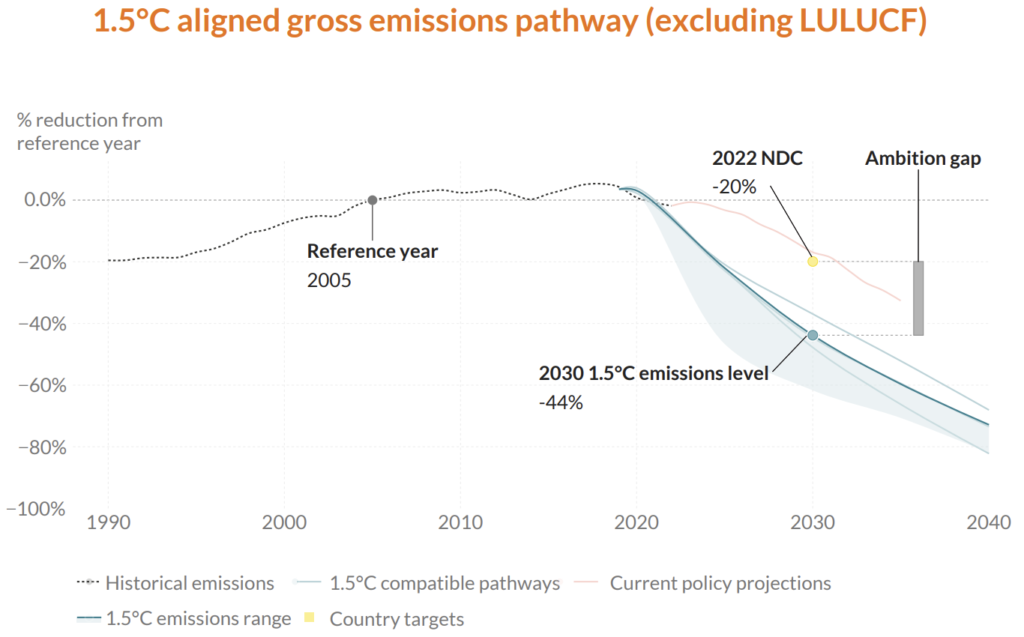
According to Climate Analytics, Australia is not currently on a trajectory that aligns with 1.5oC despite the rapid expansion of the country’s renewable power capacity because 1) the government continues to support the fossil fuel industry, 2) transport electrification is slow and 3) the Labor Government’s changes to the previous Liberal Government’s Safeguard Mechanism represent very little real improvement but rather ‘open the door to false solutions’.
There is a strong argument for the UN to completely abandon net targets and require nations to submit two targets – one for actual GHG emissions reductions and one for the amount of CO2 that nations plan to draw out of the atmosphere using nature or technology.
You are forgiven if your eyes did glaze over during all this, but please keep an eye on the NDCs the government submits to the UNFCCC (whenever they are made public) and compare them with what we should be submitting to do our bit to keep warming under 1.5.
US petrostate v Chinese electrostate
The US and China are battling to dominate the future. Not in the shipping lanes of East and SE Asia. Not over Taiwan’s independence. Not in space. Not with AI. But with energy. The US is now backing even more strongly a fossil-fuelled future, while China is rushing helter-skelter down the renewables track. It’s US petrostate v Chinese electrostate. Two examples of each side’s position follow.
Trump declared on inauguration day that the USA has an energy crisis and repeated his election call to “drill baby, drill”. He also stated, “We are a rich nation. It’s that liquid gold under our feet that will help us ensure that we keep things that way.”
Second, “There is no climate crisis, and we’re not in the midst of an energy transition, either”. These were the words of Chris Wright, Trump’s newly confirmed Secretary of the Department of Energy. Wright is the founder and CEO of Liberty Energy, an oilfield services provider, including fracking. He accepts that climate change is a global challenge, but not an urgent one and his top priority is to “unleash” domestic energy production, including LNG and nuclear power.
China’s commitment to a future powered by renewable energy is exemplified by two graphs. The first concerns China’s own transition and shows the cumulative amount of solar capacity installed month by month for each year between 2018 and 2024. No comment needed.
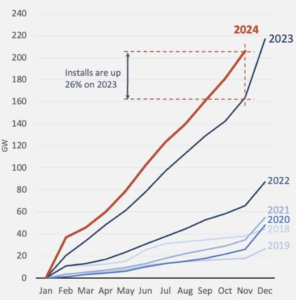
The second is indicative of China’s determination to be the major supplier of the world’s clean technology market, particularly in the emerging economies of the Global South, the major purchasers of China’s solar panels, wind generators and EVs. I doubt China is too worried about Trump’s tariff threats as, apart from batteries, they export very little cleantech to the US.
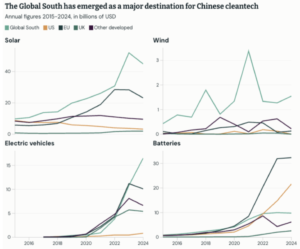
But coal consumption still rising
King Coal may be dying, but nobody seems to have told the king himself. Global coal demand grew by 1% in 2024 to an all-time high of 8.77 billion tonnes (Bt). The biggest coal users, despite the concurrent growth of their renewable energy sectors, are India and China – hardly surprising when their combined populations constitute 35% of the global population.
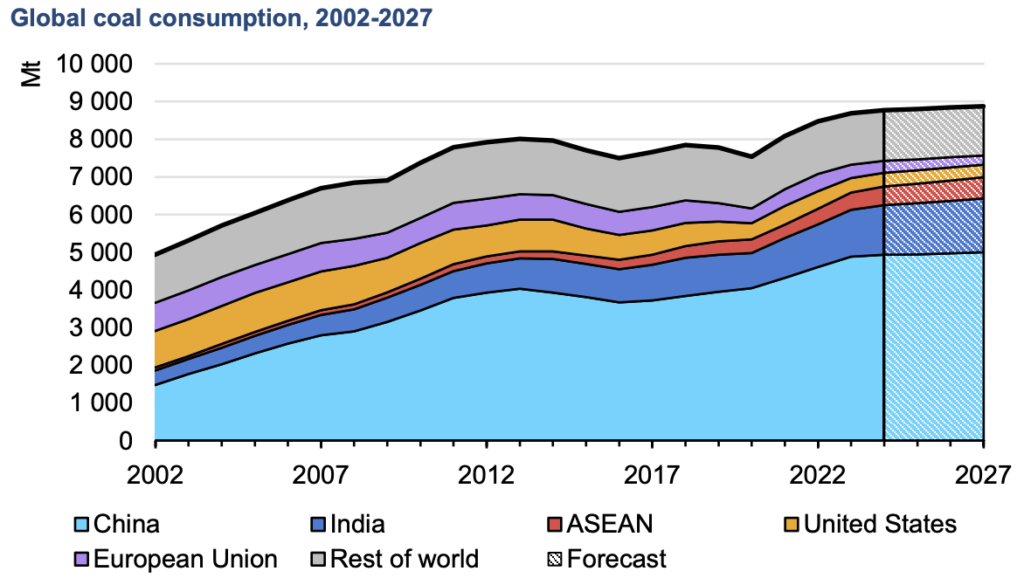
The main driver of the increasing demand for coal is electricity generation, with coal-generated electricity reaching an all-time high this year. A third of all the coal burnt worldwide goes into producing electricity just in China – its increasing demand being driven by the electrification of traditional services and the enormous demands of data centres and AI (until last week’s DeepSeek announcement anyway).
The good news is that the International Energy Agency expects global demand for coal to reach a peak of about 8.87 Bt around 2027 as the increasing demand for coal in China and India and many developing nations slows and the long-established reduction in demand in the US and Europe continues. The UK closed its last coal power plant in September 2024 – if you’d told us, nobody would have believed that when I was a kid in the north of England in the 1950s. Mind you, it was the Iron Lady, not climate change, that did most to close the mines and power stations.
The bad news is that the IEA’s annual projections of coal demand over the last five years have proven to be remarkably unreliable. As recently as 2023, they projected coal demand would then start falling.
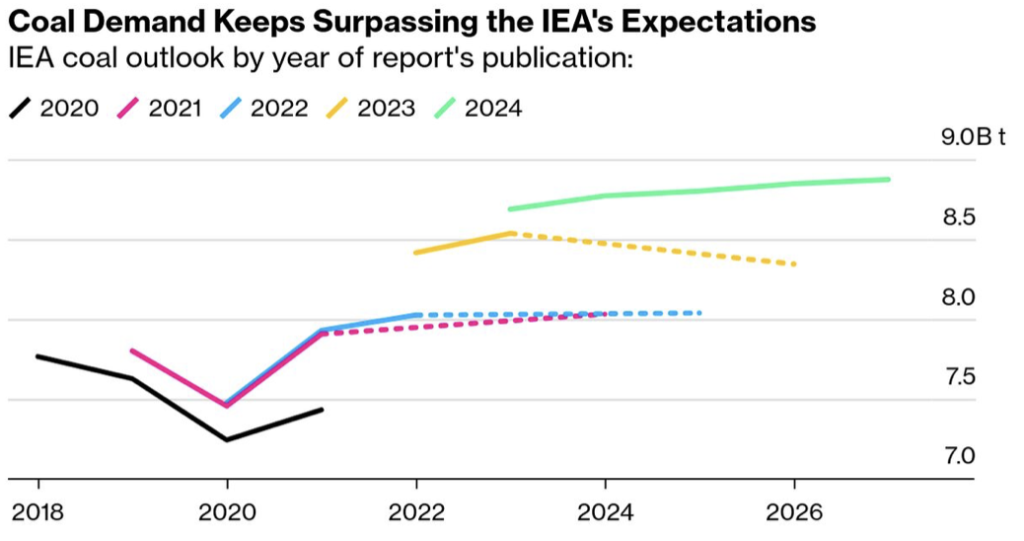
The three largest producers of coal at the moment are China (half of the total), India and Indonesia. Australia is expected to be the fourth largest producer by 2027. Although much is made of the sea-borne coal business, particularly in Australia, only about 17% of the coal produced globally is exported. Coal exporters are, however, making good profits – so why would they stop digging it up and shipping it out unless forced to do so?
Rewilding cemeteries
“Groundskeepers are changing how they tend to burial sites. They are letting grasses grow longer and reducing how much they mow. They’re ripping out invasive plants, encouraging native shrubs to thrive, forgoing pesticides, and replacing manicured turfgrass with wildflower meadows.”
Outcomes of the rewilding include greater resilience to climate change, more habitat for resident and more stepping stones for migratory native insects, grubs, frogs, birds, mammals, etc., and less need for irrigation and mowing of lawns. Rewilded cemeteries don’t need to look neglected and people are slowly becoming more accepting of wilder-looking public areas in general. I like the idea of pushing up a flannel flower or a kangaroo paw as I rot.

Wildflower meadow in Green-Wood Cemetery, Brooklyn, NY

